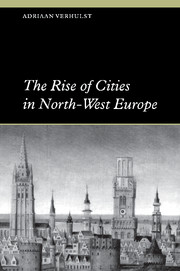Book contents
- Frontmatter
- Contents
- List of maps
- Editor's preface
- Preface
- Map
- 1 The transformation of the Roman towns
- 2 The nadir of urban life (sixth–seventh centuries)
- 3 New urban beginnings and the Viking raids (eighth–ninth centuries)
- 4 The urbanization of the high Middle Ages (tenth–eleventh centuries)
- 5 Industrialization, commercial expansion and emancipation (eleventh–twelfth centuries)
- 6 Conclusion
- Bibliography
- Index
6 - Conclusion
Published online by Cambridge University Press: 05 June 2012
- Frontmatter
- Contents
- List of maps
- Editor's preface
- Preface
- Map
- 1 The transformation of the Roman towns
- 2 The nadir of urban life (sixth–seventh centuries)
- 3 New urban beginnings and the Viking raids (eighth–ninth centuries)
- 4 The urbanization of the high Middle Ages (tenth–eleventh centuries)
- 5 Industrialization, commercial expansion and emancipation (eleventh–twelfth centuries)
- 6 Conclusion
- Bibliography
- Index
Summary
As this book is made up of chapters which examine chronologically in detail the topographical, economic and social development of every town between Somme and Meuse which was important before the thirteenth century, it would seem appropriate as a general conclusion first to draw comparisons with eligible towns in other parts of Europe during the same period and to do so within a chronological overview of the broad outlines of this development as a whole. Hopefully this will make the specific characteristics of urbanization between Somme and Meuse during the early and high Middle Ages clearer than does the monographic treatment which has often had to be used in the different chapters. Secondly, by taking a long-term approach to the fundamental factors which determined the urban phenomenon in our region, we shall try to show why north-west Europe and more specifically the Low Countries as a whole continued to be one of the most urbanized areas in the world even after the Middle Ages.
As regards the late Roman period (fourth–fifth centuries) and the transition to the sixth–seventh centuries, the development between the Somme and the Meuse is not so very different from the development that took place along the Mosel and the Rhine or to the south of the Somme. The continuity between the places with more or less urban characteristics in the fourth–fifth centuries and the same places in the sixth–seventh centuries is weaker only between the Somme and the Meuse than in the other Romanized areas. In most cases this continuity was geographical at most and not functional at all, unless from an administrative and ecclesiastical viewpoint.
- Type
- Chapter
- Information
- The Rise of Cities in North-West Europe , pp. 149 - 156Publisher: Cambridge University PressPrint publication year: 1999

